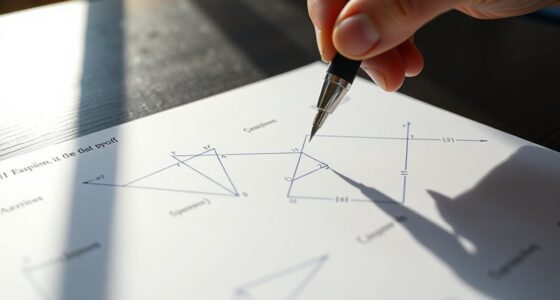Congruence and similarity are key concepts in geometry. Congruence means two shapes are exactly the same in size and shape, with matching sides and angles, verified through criteria like SAS, ASA, or SSS. Similarity occurs when shapes look alike but differ in size, with angles equal and sides proportional, based on a scale factor. Understanding these ideas helps you compare and analyze figures effectively—stay with us to explore how these concepts connect and differ even more.
Key Takeaways
- Congruence means two shapes are identical in size and shape, with matching sides and angles.
- Similarity involves shapes that are proportional in size but share the same shape, with corresponding angles equal.
- Congruent figures satisfy criteria like SAS, ASA, or SSS, confirming exact shape and size equality.
- Similar figures have corresponding angles equal and sides proportional, with a specific scale factor relating their sizes.
- The key difference is congruence emphasizes identical shape and size, while similarity focuses on proportionality and shape sameness.

Have you ever wondered what makes two shapes exactly match or look alike? It all comes down to the concepts of congruence and similarity. When you’re dealing with geometric figures, understanding how shapes relate to each other is essential. For example, two triangles might look similar but are not necessarily congruent, or vice versa. Triangle congruence happens when two triangles are exactly the same size and shape, meaning their corresponding sides and angles are identical. Recognizing triangle congruence is vital because it allows you to establish that two triangles are equal in every aspect. This can be proven through various criteria like Side-Angle-Side (SAS), Angle-Side-Angle (ASA), or Side-Side-Side (SSS). Once you verify these conditions, you confidently say the triangles are congruent, which is a powerful tool in geometry. Understanding relationships between sides and angles is fundamental in these concepts.
On the other hand, similarity involves shapes that look alike but aren’t necessarily the same size. When two figures are similar, their corresponding angles are equal, but their sides are proportional. This proportionality is where the concept of the scale factor comes into play. The scale factor is a number that describes how much a figure is enlarged or reduced when creating a similar shape. For example, if you start with a triangle and scale it up by a factor of 2, each side doubles in length, but the angles stay the same. Understanding the scale factor helps you find missing side lengths in similar figures or compare different shapes effectively. It’s a simple yet powerful tool that connects the size difference between similar figures.
Knowing the difference between congruence and similarity helps you interpret geometric problems more precisely. When shapes are congruent, you know they are identical in every way, which is often useful in proofs and constructions. When shapes are similar, you can analyze their proportions and relationships, especially when dealing with scaled drawings or models. Both concepts rely on understanding relationships between sides and angles, but they serve different purposes. Congruence emphasizes exactness, while similarity emphasizes proportionality and shape.
Frequently Asked Questions
How Do Congruence and Similarity Relate in Real-World Applications?
You can see congruence and similarity in real-world applications like scale models and architectural design. When creating a scale model, you guarantee shapes are similar, maintaining proportionality, so it accurately represents the real structure. Congruence helps in precise replication, like in detailed mock-ups. These concepts help you visualize, plan, and communicate ideas effectively, ensuring designs are accurate and proportional, whether in small models or large architectural projects.
Can Congruence and Similarity Be Combined in Geometric Proofs?
🔑 Yes, you can combine congruence and similarity in geometric proofs. By applying transformational congruence, you establish exact overlaps, while similarity criteria help you compare shapes scaled differently. You might prove parts of a figure are congruent, then use similarity to show other parts are proportional. This integrated approach allows you to demonstrate complex relationships between figures, making your proofs more exhaustive and precise.
What Are Common Mistakes When Identifying Congruent Figures?
When identifying congruent figures, you should watch out for misidentification errors that lead to faulty reasoning. Common mistakes include assuming figures are congruent based solely on appearance, ignoring specific criteria like side lengths and angles, or overlooking differences in orientation. Always verify congruence through precise measurements or geometric postulates rather than visual guesswork, ensuring your reasoning is accurate and reliable.
How Do Transformations Affect Congruence and Similarity?
Ever wondered how transformations change shapes? They can affect congruence and similarity by altering size or position. Transformation effects include rotations, reflections, translations, and dilations. When you apply a scale factor during dilation, figures become similar but not necessarily congruent. So, you see, transformations can preserve angles and shape but change size, making figures either congruent or similar depending on the type and scale factor used.
Are There Specific Tools or Software to Visualize These Concepts?
Yes, there are several tools and software for geometric visualization and educational software that help you understand congruence and similarity. Programs like GeoGebra, Desmos, and Cabri Geometry allow you to manipulate shapes and see how transformations impact congruence and similarity in real time. These tools make learning interactive and visual, helping you grasp complex concepts more effectively by exploring shapes dynamically.
Conclusion
Now that you understand congruence and similarity, think of them as two master keys opening different doors in the world of shapes. Congruence is like holding a perfect mirror—exact matches in size and shape—while similarity is like a pair of sunglasses that change the view but keep the essence. With these concepts in your toolkit, you can navigate geometric landscapes with confidence, seeing how shapes dance and connect across every twist and turn.









